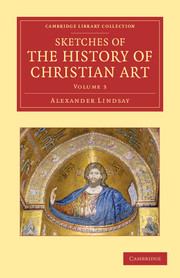
-
Select format
-
- Publisher:
- Cambridge University Press
- Publication date:
- May 2013
- June 2012
- ISBN:
- 9781139344050
- 9781108051972
- Dimensions:
- Weight & Pages:
- Dimensions:
- (216 x 140 mm)
- Weight & Pages:
- 0.56kg, 442 Pages
- Subjects:
- Art: General Interest, Art, Architecture, Western Art
You may already have access via personal or institutional login- Subjects:
- Art: General Interest, Art, Architecture, Western Art
Book description
Alexander Lindsay (1812–80) was the head of an aristocratic family who owned vast coalfields in Lancashire, generating enormous wealth. Educated at Eton and Trinity College, Cambridge, he spent the majority of his time travelling in Italy, collecting, and writing on a variety of subjects, including art, the Indo-Aryan race and the Etruscans. This important work, published in three volumes in 1847, surveys Christian painting and sculpture. Addressing Romance literature of the Middle Ages, iconography and legends of the saints, the book's historical narrative is infused with the author's strong moral approach to the subject. Volume 3 covers the schools of Siena, Florence and Bologna, then moves north to look at Cologne, Dürer, and Cranach, the Van Eycks and the Netherlandish School. Though derided by John Ruskin, the work strongly influenced aristocratic collecting, and remains relevant to readers interested in the Victorian construction of morals and artistic taste.
Contents
Metrics
Full text views
Full text views help Loading metrics...
Loading metrics...
* Views captured on Cambridge Core between #date#. This data will be updated every 24 hours.
Usage data cannot currently be displayed.
Accessibility standard: Unknown
Why this information is here
This section outlines the accessibility features of this content - including support for screen readers, full keyboard navigation and high-contrast display options. This may not be relevant for you.
Accessibility Information
Accessibility compliance for the PDF of this book is currently unknown and may be updated in the future.

